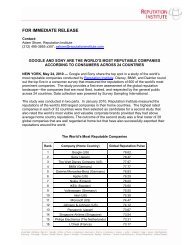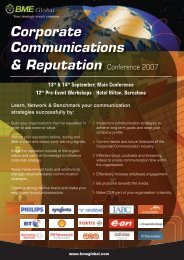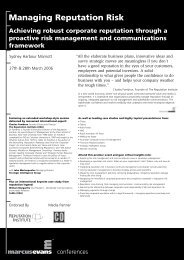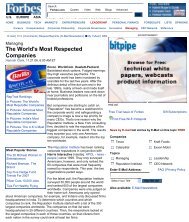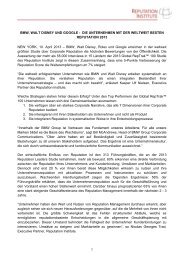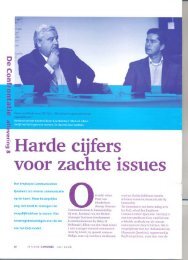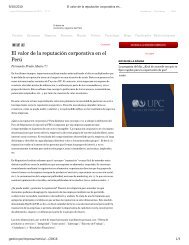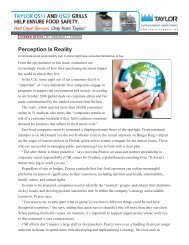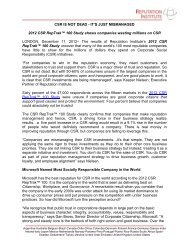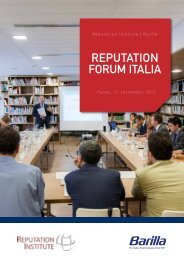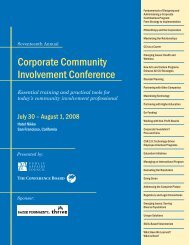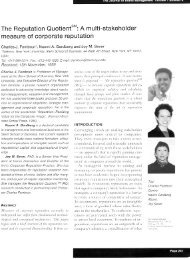The Reputation Quotient - Reputation Institute
The Reputation Quotient - Reputation Institute
The Reputation Quotient - Reputation Institute
You also want an ePaper? Increase the reach of your titles
YUMPU automatically turns print PDFs into web optimized ePapers that Google loves.
<strong>The</strong> Gauge: Fombrun and Foss on Measuring Corporate <strong>Reputation</strong><br />
08/26/2005 03:19 PM<br />
Academic efforts to quantify the value of reputation confirm that there are large<br />
economic premiums associated with corporate reputations. For instance, a study<br />
conducted at the University of Texas at Austin compared ten groups of companies<br />
with similar levels of risk and return, but different average reputation scores. Results<br />
showed that a 60% difference in reputation score was associated with a 7%<br />
difference in market value. Since an average company in the study was valued at $3<br />
billion, that means a 1-point difference in reputation score (from 6 to 7 on a 10-point<br />
scale) would be worth an additional $53 million in market value.<br />
Another project conducted at the University of Kansas suggests that reputational<br />
capital may involve even higher returns. A team of professors examined the<br />
relationship between market value, book value, profitability, and reputation for all the<br />
firms rated in Fortune’s “most admired companies” survey between 1983 and 1997.<br />
<strong>The</strong>y concluded that a 1-point change in reputation was associated with an average<br />
of $500 million in market value.<br />
More recently, the <strong>Reputation</strong> <strong>Institute</strong> examined some 35 companies whose RQ<br />
scores we had measured with Harris Interactive in both 1999 and 2000. An analysis<br />
of the stock prices of these companies revealed that a strong relationship exists<br />
between a change in RQ and a change in a company’s market value. Specifically, a<br />
positive 1-point increase in the RQ was associated with higher average market values<br />
of some $147 million, while a 1-point decrease was associated with market values<br />
that were lower by about $5 billion. <strong>The</strong>se results suggest that a ‘value spiral’<br />
operates through which better-regarded companies attract more investors who bid up<br />
their market value and further improve their reputations.<br />
<strong>The</strong> good news is that research confirms that reputations are valuable assets,<br />
however intangible. <strong>The</strong> bad news is that the size of the effect is still in question. It’s<br />
a safe bet to conclude from these studies, however, that reputations are worth a lot<br />
more than companies are now spending to manage them.<br />
PART 3<br />
So far, there are five principles we’ve learned from the <strong>Reputation</strong> <strong>Institute</strong>’s<br />
measurement and analysis of corporate reputations (See Part 1 and Part 2 of this<br />
series elsewhere in this issue):<br />
1.<br />
<strong>The</strong> Principle of Distinctiveness<br />
Strong reputations result when companies own a distinctive position in the<br />
minds of resource-holders. Take Intel and AMD, the two titans of<br />
microprocessors in the semiconductor industry. Both offer products of<br />
comparable quality, speed, and power. Yet Intel dominates AMD in the minds<br />
of computer buyers and other observers. Why? Because Intel owes its<br />
reputation, not to the quality of its products, but to the “Intel Inside” campaign<br />
that virtually defined those products as essential components of quality and<br />
high-tech ingenuity “powering” the better computers. <strong>The</strong> campaign assured<br />
Intel’s reputation as the guarantor of excellence to the end user. In short,<br />
Intel made itself distinctive.<br />
2.<br />
<strong>The</strong> Principle of Focus<br />
Strong reputations result when companies focus their actions and<br />
communications around a single core theme. Consider Johnson & Johnson.<br />
<strong>The</strong> company ranks tops in public trust. This is no accident: trustworthiness is<br />
a focal point of all J&J’s communications. It is evident in advertisements that<br />
single-mindedly portray J&J as a nurturing and caring company, with babies<br />
and children invariably featured or mentioned (despite the fact that J&J’s<br />
baby products division represents less than 7% of the company’s portfolio).<br />
3.<br />
<strong>The</strong> Principle of Consistency<br />
Strong reputations result when companies are consistent in their actions and<br />
communications to all resource-holders. Our surveys suggest that betterregarded<br />
companies are more likely to orchestrate and integrate their<br />
initiatives cross-functionally. Companies with weaker reputations suffer from<br />
maintaining compartmentalized relationships with constituents.<br />
Yet fragmentation of initiatives and communications remains the norm. Siloed<br />
staffs in Community Relations (and often in remote foundations) manage<br />
relationships with local community groups; in Investor Relations with analysts;<br />
in Advertising Departments (and in remote ad agencies) counsel on product<br />
and corporate positioning; and in Human Resources typically manage<br />
employee communications. Centripetal forces virtually guarantee<br />
inconsistency in what is said and done with a company’s different<br />
file:///guage/fombrunfossreputation1.html<br />
Page 2 of 4



